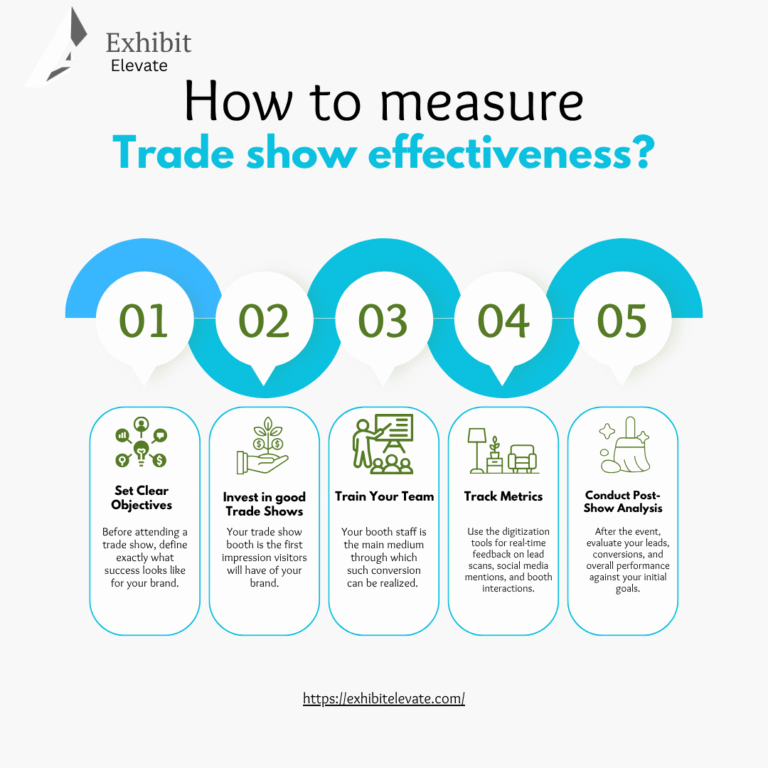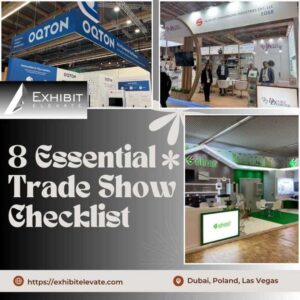Trade shows are where brands come to life. They are an excellent venue for showcasing products, meeting potential clients face to face, and making strong industry connections. However, beyond the bright lights and crowded booths is a critical question that every marketer must address: Was it worthwhile?
Participating in a trade show takes time, money, and significant resources—from designing eye-catching trade show booth displays to sending your top people on-site. Without proper evaluation, you may never know whether your efforts were beneficial or if your money could have been spent more wisely.
In this blog, we’ll break down:
- What a trade show is and why it matters for businesses
- Why measuring trade show effectiveness is crucial for marketing success
- Key metrics and proven strategies to calculate your trade show ROI
Whether you’re showcasing at a local trade show in Poland or making a mark at an international exhibition, this guide will help you turn insights into impact and ensure your next event delivers measurable results.
What is a Trade Show?
A trade show is a major commercial event where businesses in a certain industry can showcase their products or services, connect with potential customers, and network with crucial partners. These events are often conducted in large convention centers, attracting a varied range of industry professionals, decision-makers, and buyers.
Participating in a trade exhibition offers a variety of game-changing advantages:
- Directly address your target audience.
- Live product demonstrations that capture attention
- High-quality leads and sales opportunities.
- Increased brand visibility through smart trade show booth displays.
However, the ultimate success of any trade fair is determined by measurable results rather than mere attendance. Evaluating trade show effectiveness enables you to improve your marketing strategy and increase your event marketing ROI, ensuring every event delivers tangible value for your business.
Why Measuring Trade Show Effectiveness is Important?
A lot of companies may just be at trade shows because they feel it is a way of “staying ahead of competition”. But if you do not measure your performance, you might waste much money on trade show booth design, displays, and marketing campaigns that are not giving back enough. Important benefits from this method are:
- Compute Trade Show ROI: Look at the number of leads and sales that were made.
- Evolve the Future Strategy: Recognize the successful and unsuccessful areas of your trade show marketing strategy.
- Validate Budgets: Report to the management the outcome based on data so that they take into consideration the information when planning future.
Concentrate on Top Performing Events: Which ones among these would be—whether near or in Poland, a trade show in Poland or other worldwide expos.

Key Metrics to Measure Trade Show Effectiveness
1. Lead Generation and Quality
The most trade shows, simple gold, are to obtain new leads. However, it is critical to acknowledge that not all leads have equal cost. Keep track of both the number and the quality of leads that you bring in.
Main Indicators:
- Number of total leads
- Percentage of qualified leads
- Lead conversion rate of qualified to paying customers
Tip: Set up necessary lead sources for your trade show booth to quickly capture, organize, and bestow in real time.
2. Sales and Revenue Generated
The amount of sales made during or after the trade show is the best predictor of trade show ROI. Consider how the aggregate sales contribution affects the total cost.
Here is a Calculation Example:
In the case, your company pays $20,000 on a trade show and they make $60,000 in confirmed sales, then your ROI will be 200%.
3. Booth Traffic and Engagement
A creative trade show booth design and hands-on demos such as: are two of the methods you can use to rise up above your competition. Keep track:
- The number of people who visit your booth
- The time clients spend when interacting with the employees
- Participation in demos or activities
Using trade show displays such as digital screens, virtual trauma exposures, or product demonstrations can significantly boost up engagement.
4. Brand Awareness and Visibility
It isn’t always possible that a memorable trade show ends up in sales. It takes time for brands to be recognized and slowly but surely generated conversion. Here are the main markers you ought to look into:
- Increased social media engagement and follower count
- Book stalls in your website that attract visitors on a short-term basis
- Presence in media or having being mentioned by the press
Trade show marketing strategy that included digital promotions, capture the clicks and engagement specific to the given event.
5. Networking and Partnerships
Trade exhibits are not simply key to acquiring sales—even in the absence of a purchase, it is possible to orchestrate a profitable relationship. Aided by the following metrics, have a check on the percentage of concrete relations you build:
- Company representatives
- Distributors and/or suppliers who are candidates to represent your business
- Editors and influencers
Your event marketing ROI can even tally because of a single partnership if it were strategic.
6. Cost Analysis and Budget Performance
Measuring nation trade effectiveness however means not only to know the sales but to have the complete picture such as:
- Booth fee hosting and trade show booth design
- Transport and lodge expenses
- Advertising and sales promotion materials
- Worker and wage spending
Once you have done this, figure out the difference in these costs and the sales and qualified leads to obtain the nation ROI of the trade show.

Best Practices to Improve Trade Show Effectiveness
1. Set Clear Objectives
Do the necessary pre-work and define success in advance like do you necessarily want to do the following among other things:
- Are you going to produce a targeted number of leads?
- Played to direct sales?
- Insert the new product?
Good objectives clarity will cause the easier to measure results and ROI calculation.
2. Invest in Attractive Trade Show Booths
The stand is the first image of your company to the public. A trade show booth with a professional design will be able to:
- Boost foot traffic
- Strengthen engagement
- Exhibit the identity of your brand
He/she may use interactive trade show displays with banners and lights for drawing the attention to him/her.
3. Train Your Team for Engagement
Your booth staff is the main medium through which such conversion can be realized. Here is a list of your booth staff to be:
- Friendly and knowledgeable about your products or services
- Equipped with appropriate sales materials
- Prepared to capture lead information efficiently
It is an upbeat team that brings a lot of value to your trade show effectiveness.
4. Track Metrics During the Event
Use the digitization tools for real-time feedback on lead scans, social media mentions, and booth interactions. This helps you to:
- Adjust strategies if engagement is low
- Identify popular aspects of your trade show displays
- Gather immediate feedback on your trade show marketing strategy
5. Conduct Post-Show Analysis
Immediately post-show it is necessary to:
- Review leads and conversions
- Calculate your trade show ROI
- Identify areas of improvement for future events
This is an identification process, without which no success will last, be it in the case of you as a company and in particular, being able to attend to events of such a caliber as trade show in Poland or others.
Final Thoughts
Measuring trade show effectiveness is among the things you do to ensure that your investments in advertising bring returns. Once you have collected enough leads, visitors and sales, etc you can measure your event marketing ROI and use data to drive business forward.
Whether your participation is in a local fair or a major international trade show in Poland, a customized trade show booth, a clear marketing plan, and a thorough post-show analysis will help you gain measurable advantages. Careful and timely planning, combined with effective execution and post-event analysis, is key to achieving the highest level of success. Therefore, treat trade show ROI as a vital part of a structured approach—plan, execute, and evaluate with intention.
In addition to these strategies, consistently tracking and monitoring your performance metrics can transform the way you approach exhibitions. As a result, trade shows will no longer be just about having a physical presence—they will become powerful platforms for driving business growth and building your brand.



